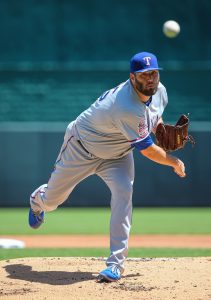The Rangers began 2020 with playoff aspirations, but almost halfway through the campaign, it appears they’ll fall short of their goal. Texas will enter Tuesday’s action a dismal 11-17, 3 1/2 games out of wild-card position and well on its way to a fourth straight season without a playoff berth. Consequently, the Rangers could end up as sellers prior to the Aug. 31 trade deadline. If that’s the case, they may have one of the game’s most appealing trade chips in right-hander Lance Lynn. Although he still has another year of control left after this one, the Rangers are at least “entertaining” offers for Lynn, Ken Rosenthal of The Athletic writes (subscription link).
Of course, just because the Rangers are willing to listen to teams’ proposals for Lynn doesn’t mean they’re ready to move him. However, there’s a case the Rangers should sell high on Lynn, a former Cardinal, Twin and Yankee who has been brilliant in Texas.
Since signing a three-year, $30MM contract with the Rangers before 2019, Lynn has pitched to a 3.30 ERA/3.17 FIP over 253 2/3 innings. Lynn was an American League Cy Young contender during his first season in Texas, and it appears he’ll be in the thick of the race this year. Through a major league-leading 45 1/3 innings in 2020, Lynn has recorded a 1.59 ERA/3.35 FIP with 9.93 K/9 and 2.78 BB/9.
With only a few weeks left in the regular season, teams may be loath to surrender significant value for most players available around the deadline, as the majority are pending free agents who aren’t vying for major awards. But Lynn’s a Cy Young hopeful who would be able to help a team this year and next, when he’ll be due an affordable $8MM salary, so the Rangers should be in position to land a quality haul for the 33-year-old if they do part with him in the next several days.

